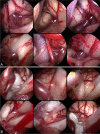A multivariable prediction model for recovery patterns and time course of symptoms improvement in hemifacial spasm following microvascular decompression
- PMID: 35103860
- PMCID: PMC8913470
- DOI: 10.1007/s00701-022-05133-w
A multivariable prediction model for recovery patterns and time course of symptoms improvement in hemifacial spasm following microvascular decompression
Abstract
Background: Microvascular decompression (MVD) success rates exceed 90% in hemifacial spasm (HFS). However, postoperative recovery patterns and durations are variable.
Objective: We aim to study factors that might influence the postoperative patterns and duration needed until final recovery.
Method: Only patients following de-novo MVD with a minimum follow-up of 6 months were included. Overall trend of recovery was modeled. Patients were grouped according to recognizable clinical recovery patterns. Uni- and multivariable analyses were used to identify the factors affecting allocation to the identified patterns and time needed to final recovery.
Results: A total of 323 (92.6%) patients had > 90% symptom improvement, and 269 (77.1%) patients had complete resolution at the last follow-up. The overall trend of recovery showed steep remission within the first 6 months, followed by relapse peaking around 8 months with a second remission ~ 16 months. Five main recovery patterns were identified. Pattern analysis showed that evident proximal indentation of the facial nerve at root exit zone (REZ), males and facial palsy are associated with earlier recovery at multivariable and univariable levels. anterior inferior cerebellar artery (AICA), AICA/vertebral artery compressions and shorter disease durations are related to immediate resolution of the symptoms only on the univariable level. Time analysis showed that proximal indentation (vs. distal indentation), males and facial palsy witnessed significantly earlier recoveries.
Conclusion: Our main finding is that in contrast to peripheral indentation, proximal indentation of the facial nerve at REZ is associated with earlier recovery. Postoperative facial palsy and AICA compressions are associated with earlier recoveries. We recommend a minimum of 1 year before evaluating the final outcome of MVD for HFS.
Keywords: Delayed recovery; Hemifacial spasm; Microvascular decompression; Time course of recovery.
© 2022. The Author(s).
Conflict of interest statement
The authors declare no competing interests. We have only to mention that Henry W. S. Schroeder was a consultant to Karl Storz SE & Co. KG, Tuttlingen, Germany.
Figures





References
-
- Abdul-Wahab SA (2011) Sick building syndrome: in Public buildings and workplaces. Springer Science & Business Media
Publication types
MeSH terms
LinkOut - more resources
Full Text Sources

